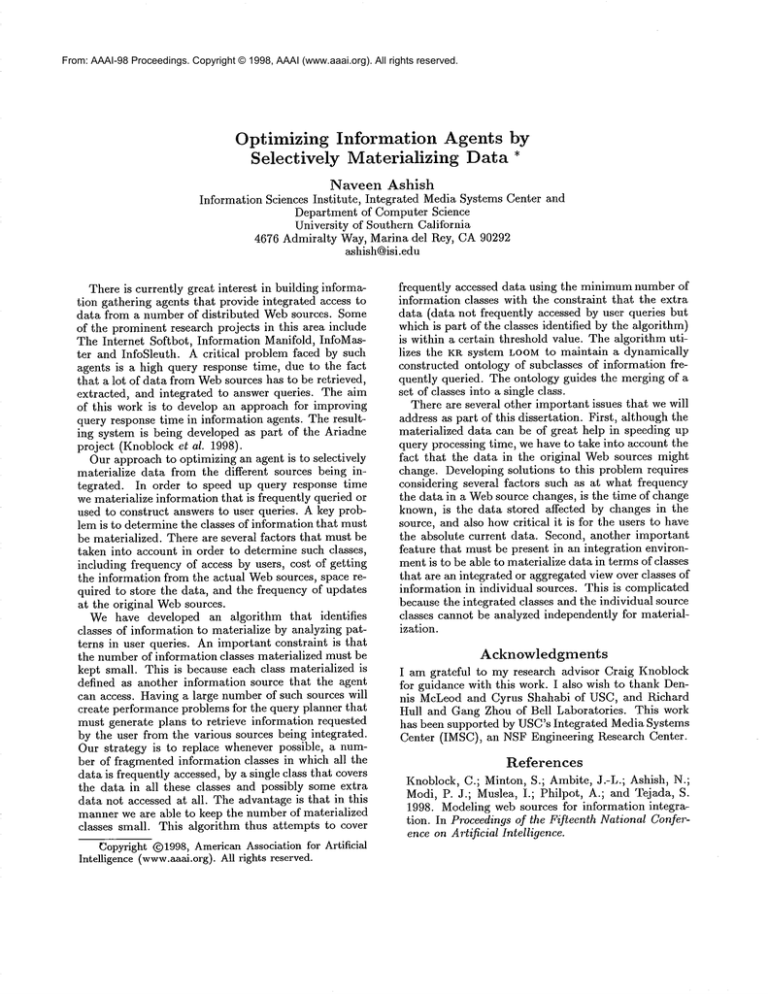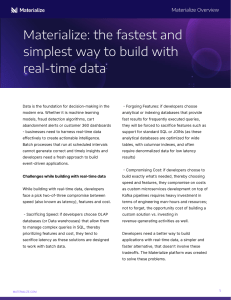
From: AAAI-98 Proceedings. Copyright © 1998, AAAI (www.aaai.org). All rights reserved.
Optimizing Information Agents by
Selectively Materializing Data *
Naveen Ashish
Information Sciences Institute, Integrated Media Systems Center and
Department of Computer Science
University of Southern California
4676 Admiralty Way, Marina del Rey, CA90292
ashish@isi.edu
There is currently great interest in building information gathering agents that provide integrated access to
data from a number of distributed Websources. Some
of the prominent research projects in this area include
The Internet Softbot, Information Manifold, InfoMaster and InfoSleuth. A critical problem faced by such
agents is a high query response time, due to the fact
that a lot of data from Websources has to be retrieved,
extracted, and integrated to answer queries. The aim
of this work is to develop an approach for improving
query response time in information agents. The resulting system is being developed as part of the Ariadne
project (Knoblocket al. 1998).
Our approach to optimizing an agent is to selectively
materialize data from the different sources being integrated. In order to speed up query response time
we materialize information that is frequently queried or
used to construct answers to user queries. A key problem is to determine the classes of information that must
be materialized. There are several factors that must be
taken into account in order to determine such classes,
including frequency of access by users, cost of getting
the information from the actual Websources, space required to store the data, and the frequency of updates
at the original Websources.
We have developed an algorithm that identifies
classes of information to materialize by analyzing patterns in user queries. Animportant constraint is that
the numberof information classes materialized must be
kept small. This is because each class materialized is
defined as another information source that the agent
call access. Havinga large numberof such sources will
create performance problems for the query planner that
must generate plans to retrieve information requested
by the user from the various sources being integrated.
Our strategy is to replace wheneverpossible, a number of fragmented information classes in which all the
data is frequently accessed, by a single class that covers
the data in all these classes and possibly some extra
data not accessed at all. The advantage is that in this
manner we are able to keep the number of materialized
classes small. This algorithm thus attempts to cover
~opyright Q1998,AmericanAssociation for Artificial
Intelligence (www.aaai.org).All rights reserved.
frequently accessed data using the minimumnumber of
information classes with the constraint that the extra
data (data not frequently accessed by user queries but
whichis part of the classes identified by the algorithm)
is within a certain threshold value. The algorithm utilizes the Kl% system LOOM tO maintain a dynamically
constructed ontology of subclasses of information frequently queried. The ontology guides the merging of a
set of classes into a single class.
There are several other important issues that we will
address as part of this dissertation. First, although the
materialized data can be of great help in speeding up
query processing time, we have to take into account the
fact that the data in the original Websources might
change. Developing solutions to this problem requires
considering several factors such as at what frequency
the data in a Websource changes, is the time of change
known, is the data stored affected by changes in the
source, and also howcritical it is for the users to have
the absolute current data. Second, another important
feature that must be present in an integration environmentis to be able to materialize data in terms of classes
that are an integrated or aggregatedview over classes of
information in individual sources. This is complicated
because the integrated classes and the individual source
classes cannot be analyzed independently for materialization.
Acknowledgments
I am grateful to my research aclvisor Craig Knoblock
for guidance with this work. I also wish to thank Dennis McLeodand Cyrus Shahabi of USC, and Richard
Hull and Gang Zhou of Bell Laboratories. This work
has been supported by USC’sIntegrated Media Systems
Center (IMSC), an NSFEngineering Research Center.
References
Knoblock, C.; Minton, S.; Ambite, J.-L.; Ashish, N.;
Modi, P. J.; Muslea, I.; Philpot, A.; and Tejada, S.
1998. Modelingweb sources for information integration. In Proceedingsof the Fifteenth National Conference on Artificial Intelligence.












